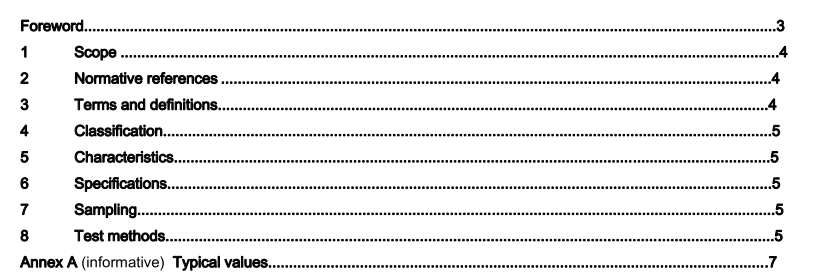BS EN 14260:2003 – Derivatives from coal pyrolysis — Coal tar and pitch based binders and related products: road tars — Characteristics and test methods

1 Scope
This European Standard specifies the methods of test required to determine the characteristics for “road tars“ and their warning to use for the industrial purposes.
Depending on the required application and the desired properties of the end product, different grades of road tars are available.
2 Normative references
This European Standard incorporates by dated or undated reference, provisions from other publications. These normative references are cited at the appropriate places in the text, and the publications are listed hereafter. For dated references, subsequent amendments to or revisions of any of these publications apply to this European Standard only when incorporated in it by amendment or revision. For undated references the latest edition of the publication referred to applies (including amendments).
EN 1426, Bitumen and bituminous binders – Determination of needle penetration
EN 1427, Bitumen and bituminous binders – Determination of softening point – Ring and Ball method
EN 13357, Bitumen and bituminous binders – Determination of the efflux time of petroleum cut-back and fluxed bitumens
prEN 13702-1, Bitumen and bituminous binders – Determination of dynamic viscosity of modified bitumen – Part 1 : Cone and plate viscometer method
prEN 13702-2, Bitumen and bituminous binders – Determination of dynamic viscosity of modified bitumen – Part 2 : Coaxial viscometer method
EN 13847:2001, Coal tar and pitch based binders and related products – Terminology and classification”
EN ISO 2719, Determination of flash point – Pensky-Martens closed cup method (ISO 2719:2002)
EN ISO 3838, Crude petroleum and liquid or solid petroleum products – Determination of density or relative density – Capillary-stoppered pyknometer and graduated bicapillary pyknometer methods (ISO 3838:1983)
ISO 3733, Petroleum Products and bituminous materials – Determination of water – Distillation method
ISO 6257, Carbonaceous materials used in the production of aluminium – Pitch for electrodes – Sampling
NF T 66-029, Liants hydrocarbonés-Goudrons purs – Détermination de la teneur en naphtalène
NF T 66-030, Liants hydrocarbonés- Goudrons purs – Détermination de la teneur en anthracène
BS 76:1974, Specification for Tars for road purposes
3 Terms and definitions
For the purposes of this European Standard, the terms and definitions given in EN 13847:2001 apply.
4 Classification
For the purposes of this European Standard, the classification according to EN 13847:2001 applies.
5 Characteristics
The following characteristics shall be determined:
a) Water content,
b) Density;
c) Efflux time (cannot be used for modified road tars);
d) Distillation;
e) Softening point;
f) Softening point of distillation residue on 300 ° C;
g) Needle penetration;
h) Naphthalene fraction content;
i) Anthracene fraction content;
j) Flash point (close cup);
k) Dynamic viscosity curve for modified road tars measured between 80 ° C and 120 ° C at 4 different
temperatures with an interval of approximately 10 ° C between each temperature.
6 Specifications
Specifications of the national standards bodies shall be used.
The typical values given in annex A can be used as requirements.
7 Sampling
The ISO 6257 specifies methods for sampling and preparing samples for testing of road binders.
These methods are applicable to all grades of road tars in liquid or solid form, the latter having softening points higher than 30 ° C (determined according to the method EN 1427) in bulk, or in a numbers of containers making up one batch at sites of manufacture, storage of delivery.
8 Test methods
For the determination of the characteristics according to clause 5, the methods listed in Table 1 have to be used.
BS EN 14260:2003 – Derivatives from coal pyrolysis — Coal tar and pitch based binders and related products: road tars — Characteristics and test methods